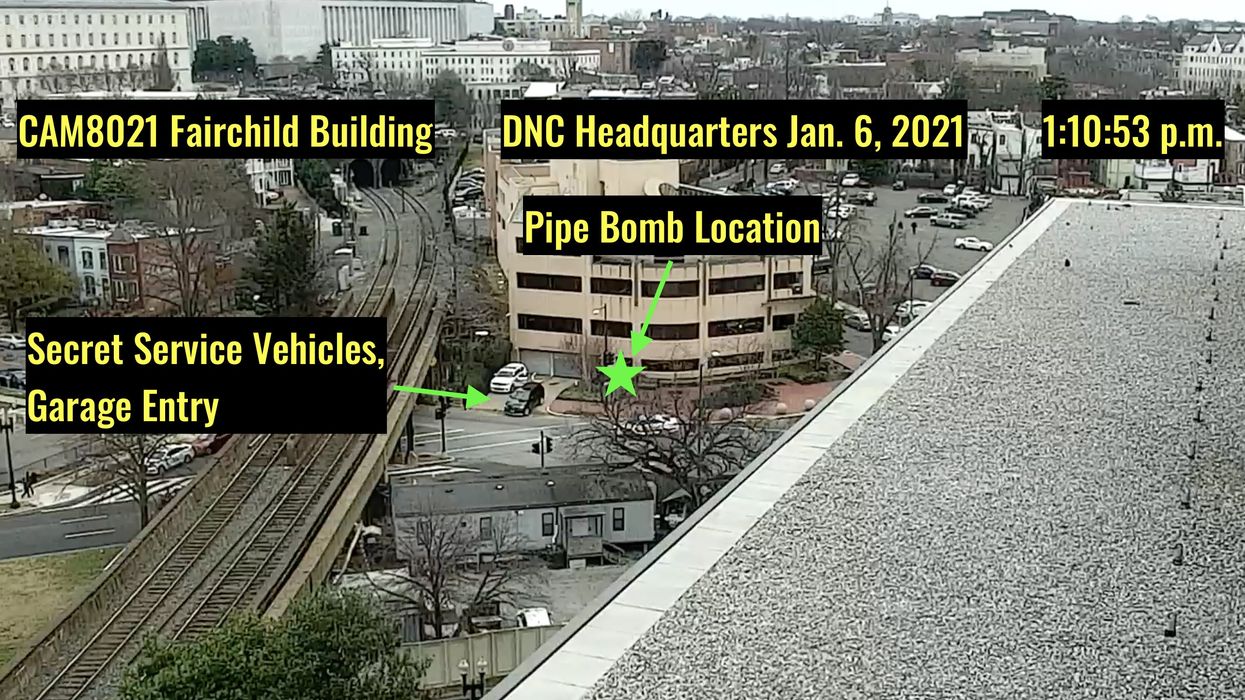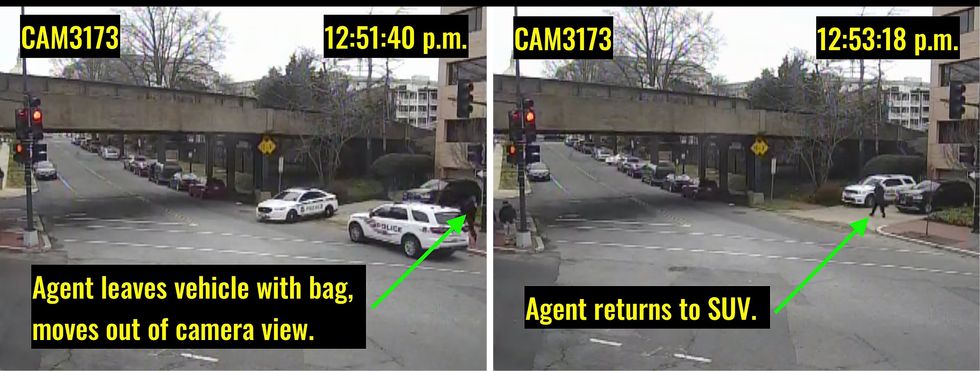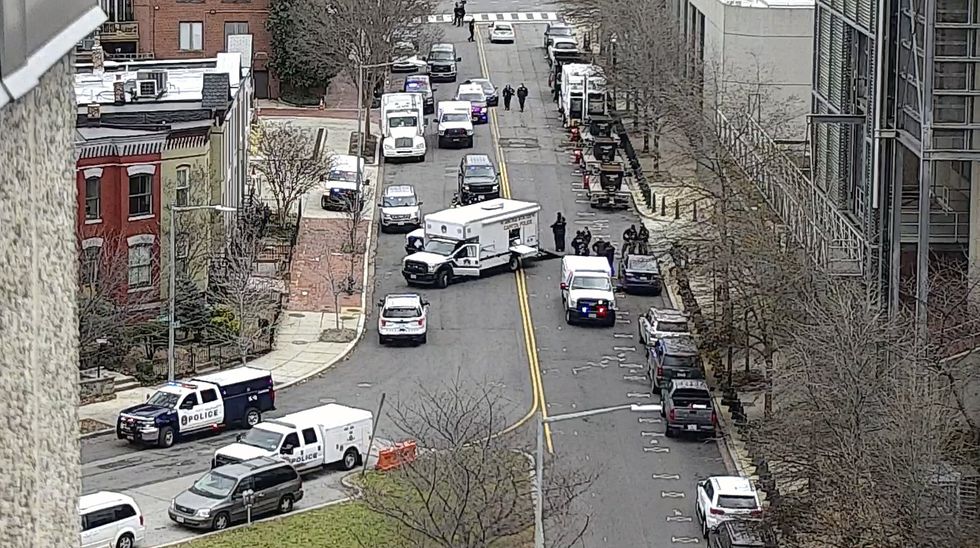
Photo from US Capitol Police CCTV camera 8021 on Jan. 6, 2021.

The FBI is withholding key security video that could break the case, a Capitol Hill source tells Blaze News.
Congressional investigators are examining the possibility that the pipe bomb planted outside Democratic National Committee headquarters in Washington, D.C., in 2021 was left near a park bench at midday on January 6 — while Vice President-elect Kamala Harris was inside the building for as-yet-unexplained meetings.
A senior congressional investigator told Blaze News the latest theory is that the DNC bomb was planted less than 15 minutes before it was discovered at 1:05 p.m. That would mean the bomb was placed near a park bench on the southwest side of the DNC building 22 minutes before Harris was removed — not 17 hours earlier, as long claimed by the FBI.
The DNC device was discovered by a plainclothes Capitol Police counter-surveillance officer who was sent to the DNC on Jan. 6 after a pipe bomb was found behind the Capitol Hill Club near the Republican National Committee office at 12:43 p.m. Each bomb was attached to a 60-minute kitchen timer, the FBI has said.
The new timeline being explored by congressional investigators raises troubling questions with heavy implications. Why didn’t the U.S. Secret Service find the bomb during two security sweeps on Jan. 6 if the device was actually planted after 7 p.m. the night before, as the FBI insists?
The canine sweep inexplicably did not include the bushes where the pipe bomb was later located.
If it is possible that the DNC bomb was placed shortly before it was discovered on Jan. 6, why hasn’t the FBI released security video from the southwest side of the DNC building that would identify the culprit and pin down the exact day and time the bomb was placed?
The Capitol Hill investigation of the pipe bombs has taken on new life 43 months after Jan. 6 with release of the Department of Homeland Security Office of Inspector General report on the mistakes made by the Secret Service on Jan. 6.
The congressional probe has also taken on new urgency with the colossal July 13 Secret Service security failure that led to the near-assassination of former President Donald J. Trump at a rally in Butler, Pennsylvania.
This new information is being generated not from evidence released by the FBI, Secret Service, or other law enforcement but from congressional investigators and independent news media, including Blaze News, Revolver News, and Declassified with Julie Kelly.
One of the earliest questions posed since the discovery of the DNC pipe bomb on Jan. 6 was how the Secret Service could have missed the device if it conducted a proper sweep with a bomb-sniffing dog.
According to the July 24 report from DHS Inspector General Joseph V. Cuffari, two Secret Service K-9 teams swept the DNC property between 8:30 a.m. and 10:30 a.m. in preparation for Harris’ arrival on Jan. 6. One team swept the building interior along Harris’ planned walking path.
The Secret Service site supervisor, however, “did not instruct the canine teams to sweep any part of the exterior of the building,” Cuffari wrote in his 82-page report. Despite this, one of the canine teams did sweep “certain exterior areas” around the garage entrance but “did not include the bushes where the pipe bomb was located,” the OIG report said.
Even with the partial canine sweep along the southwest side of the building, the bomb-sniffing dog came within feet of where the pipe bomb was later discovered. The bomb location was nine feet from the entry door and 20 feet from the center of the driveway where Harris’ motorcade passed just before 11:30 a.m.
The FBI determined the Jan. 6 pipe bombs were "viable" explosive devices that could have cost lives and caused extensive property damage. A congressional source told Blaze News that the devices were mostly inert with just enough gunpowder inside to trigger a bomb-sniffing dog.
According to the new theory being explored by congressional investigators, the pipe bomb was not present when the security sweep was done or when Harris arrived from the Capitol.
Investigators have been hampered by the fact that key U.S. Capitol Police security cameras were intentionally aimed away from the rear of the DNC building at the time — or they would have captured the security sweep and the time the device was actually placed.
'This could have been the worst assassination since JFK.'
The best vantage point over the DNC garage entrance and the southwest side of the building was U.S. Capitol Police camera 8021, located on the side of the nearby Fairchild Building. According to a review of that camera footage by Blaze News, the device was pointed west, away from the DNC, until five minutes after discovery of the bomb.
By the time the camera was moved back to focus on the DNC building, the pipe bomb had been found and the Secret Service vehicles in the driveway were moving to allow Harris’ entourage to drive out through the garage entrance.
Another Capitol Police security camera provided a partial view of the DNC garage entrance before and during Harris’ visit. Although camera 3173 did not reach quite far enough to cover the exact pipe bomb location near the park bench, it did reveal clues that have led to suspicion that the bomb was planted at approximately 12:52 p.m. on Jan. 6.
According to security camera footage captured by camera 3173, Harris’ entourage of three dark, armored SUVs pulled into the DNC driveway just after 11:25 a.m.
We don't know what meetings the vice president-elect was attending at the DNC that day. Nearby, a joint session of Congress was about to meet to take up objections to Electoral College balloting from the 2020 presidential election. Harris was a sitting U.S. senator at the time, and the debate could have had serious bearing on her ability to assume office on Jan. 20 if protests and rioting had not interrupted the session.
At 12:03:40 p.m., a Metropolitan Police Department SUV pulled up to the driveway and the driver emerged to speak with Secret Service agents, video showed. About 90 seconds later, two of the Secret Service agents got into the MPD vehicle with the MPD officer and departed.
At 12:08:38 p.m., the SUV returned and parked near the DNC driveway. One Secret Service agent got out and opened the hatchback. A heavy-set plainclothes agent walked into view from the sidewalk off camera and removed something from the passenger side of the vehicle and placed it in the back.

The driver removed a reflective yellow jacket, a white grocery sack, and what appeared to be a black garbage bag from the back seat and placed those items in the rear cargo area, the video showed. He then retrieved several other small white grocery sacks or fast-food-type bags from the rear seat and placed them in the back of the SUV. The MPD officer then retrieved what appeared to be documents and placed them in the cargo compartment.
The MPD officer and one of the plainclothes agents closed the hatchback, got back into the SUV, and drove away at 12:10:47 p.m., security video showed.
The same SUV returned at 12:51:39 p.m., and one of the plainclothes agents got out of the rear passenger door and walked into one of the camera's blind spots — where the pipe bomb was later found. The SUV pulled forward and backed into the DNC driveway, replacing an MPD squad car that was previously in the spot.
The plainclothes agent walked back from the camera's blind spot at 12:53:18 p.m. and proceeded to get back into the MPD vehicle that was now parked in the DNC driveway, the video showed.
A Capitol Hill source told Blaze News that some investigators suspect the pipe bomb was placed during this time frame. Without the superior view offered by camera 8021 or the DNC security video held by the FBI, it is far from certain, however, who placed the device.
The timing suggested by this theory could be significant, since the first breach of the Capitol grounds by protesters occurred at 12:53 p.m. The growing crowd of hundreds of protesters moved quickly from the Peace Fountain through a lightly defended police line to the Capitol.
By 1:06 p.m. — when Capitol Police opened fire with crowd-control projectiles — protesters occupied most of the West Plaza.
Inspector General Cuffari’s report said the Secret Service should have done a canine sweep of the bushes along the DNC’s southwest side. Agents failed to arrange for an explosives ordnance disposal team to be on site during the sweeps. A specialist site coordinator should have been brought to the bomb site, which the OIG report said would have prevented the failure of canine teams to sweep the bushes for explosives, the report said.
The Secret Service also failed to define and record the Jan. 6 pipe bomb as an “Unusual Protective Event” as required by its own regulations, Cuffari wrote.
The nonchalant demeanor of Secret Service agents after discovery of the DNC pipe bomb caught the attention of U.S. Rep. Thomas Massie (R-Ky.), who released a video in July 2023 showing a distinct lack of urgency. Massie said it appeared the Secret Service agents and the MPD officer finished eating their lunches before exiting the vehicles to investigate the pipe bomb.
Every investigator and law enforcement official contacted by Blaze News over the past year said the Secret Service broke several protocols on Jan. 6, including lack of effective use of bomb-detection dogs, failure to establish a safe perimeter and prevention of pedestrian access to the bomb site, and a neglect to stop rail traffic on the trestle that runs alongside the DNC building.
The OIG report said that after discovery of the pipe bomb, the Secret Service detail leader “decided to evacuate the building immediately.” However, it took 11 minutes from discovery of the bomb until Harris' motorcade rolled out of the DNC garage, traveled around the block to the building entrance, and retrieved Harris, security video showed.
The Secret Service originally planned to return Harris to the Capitol at 1:30 but were talked out of it by an MPD officer who heard reports of violence between police and protesters. The congressional investigator said this is an example of "siloed" communications, where Harris' Secret Service team was not in contact with Vice President Mike Pence's security detail or other agents at the Capitol.
Poor communication has already emerged as a factor in the near-assassination of former President Trump. The Secret Service did not stage an agent in the command center of state and local police and missed crucial radio broadcasts indicating that a man was on a nearby roof with a rifle. As a result, U.S. Sens. Ron Johnson (R-Wis.) and Chuck Grassley (R-Iowa) said poor communication nearly got Trump killed by would-be assassin Thomas Matthew Crooks.
Since shortly after the discovery of the pipe bombs, the FBI said a mysterious hooded individual placed the pipe bombs at the RNC and DNC the night of Jan. 5. Security video was released showing a suspect moving between the two sites. Grainy security video from the DNC — captured at a barely workable five frames per second — showed the suspect sitting on a park bench behind the DNC. The video did not show the actual placement of a bomb.
Kyle Seraphin, a former FBI special agent assigned to do surveillance on a person of interest in the pipe bomb case, said he was told in a March 2021 FBI briefing that the pipe bombs were not a threat.
“They were not viable devices," Seraphin said in an Aug. 2 interview with Blaze News. "‘Inoperable.’ ‘Looked very bomb-like,’ was the quote that I remembered.”
“We have a lot of people that worked for the FBI who are willing to fudge the truth or use shaded versions or definitions of the word ‘viability,'" he said.
Seraphin's surveillance team was brought in to gather intelligence on someone thought to be connected to the hooded Jan. 5 stranger.
"When you work surveillance, you want to know some things about your target," Seraphin said. "Is this a witness? Is it someone who's not a threat to us? Oh, is this an MS-13 gang member? Have they allegedly hacked people up with a machete? I want to know that. Like, what is my threat?"
Seraphin and his team were abruptly pulled off the case without explanation after tracking a vehicle and a D.C. Metrorail card. The person being surveilled in that case did not match the physical description of the hooded suspect.
Seraphin's name came up in a June 7, 2023, transcribed interview with Steven D'Antuono, former head of the FBI's Washington field office, with two members of the House Judiciary Committee. Rep. Thomas Massie (R-Ky.) asked D'Antuono about Seraphin's contention that the pipe bombs were not "viable" explosives.
"All I know is that we, at the Washington field office, received a report from the lab division, which are the bomb experts — I don't know what Kyle's expertise in bomb-making is — that they were viable devices," D'Antuono said. "So the only thing I could go by is what my lab said, and not what Kyle says."
Seraphin said he spent 100 hours on demolition training in the U.S. military and has used commercial and military-grade dynamite. He has done electric and non-electric demolitions, he said.
"That's one of those quirky things, why would you bring my name up to specifically discredit it?" Seraphin asked. "Unless that was an actual threat to what was the lie that they were telling."
"To me, having seen what they have done recently, I know they don't have a problem lying to Congress," Seraphin added. "As long as they think they're not going to get caught."
The Jan. 6 pipe bombs case is a "catastrophic failure," given the FBI's vast resources and more than 43 months with no arrests, he said.
"The idea that they would have all of those resources — and it's the biggest case the FBI has ever worked," Seraphin said. "The fact that they didn't catch the most terroristic person on that day … that will forever live in infamy. It’s absurd to me on every level. It defies credulity."
The FBI had no comment on the idea that the DNC bomb could have been placed on Jan. 6. "The investigation is ongoing into who placed the pipe bombs on January 5, 2021," the FBI National Press Office told Blaze News, referring readers to its January pipe bombs update.
Massie expressed amazement at what he saw as the lack of curiosity by the now-defunct Jan. 6 Select Committee about the DNC bomb and what it could have meant for the country.
In a February 2024 House Rules Committee hearing, Massie upbraided the former committee's co-chairman, Rep. Bennie Thompson (D-Miss.), for the lack of pipe-bomb details in the committee’s final report.
“So you’re in charge of the entire investigation of what happened on January 6 and what led up to January 6 and you don’t know that the vice president … the incoming vice president was in the DNC when that pipe bomb was sitting there?” Massie asked. “If this bomb had gone off just a few feet from her, this could have been the worst assassination since JFK.”
The investigation has been frustrated by the Secret Service's decision to wipe all of its agents' phones after Jan. 6, despite admonition from four congressional committees to preserve all Jan. 6 information and a warning from the inspector general not to delete digital information related to Jan. 6.
In February 2022, the Secret Service notified Cuffari that it had wiped "all phones" when it updated software between January and April 2021 and "did not have backup files." Thus it was unable to provide emails or text messages between agents on Jan. 6.
The Secret Service told the OIG that the system migration was planned before Jan. 6, although employees were sent information on how to use screen captures to maintain copies before the deletion dates, the report said.

“If four committees of Congress gave a preservation notice and the Secret Service deleted those communications, that’s obstruction of Congress," Massie said. "I think we should still be looking into that, regardless of when we found out about it and, frankly, regardless of who the president is."
The Secret Service response to the DNC pipe bomb, coupled with Capitol Police's manipulation of CCTV security cameras at key moments on Jan. 6, continues to generate questions 43 months into the investigation.
Pedestrians were allowed to traverse the sidewalk just feet from the bomb. Vehicles continued driving past the DNC building before Harris was extracted from the building, and Capitol Police deployed a bomb robot to destroy the device. According to the federal Office for Bombing Prevention, the minimum evacuation zone for a pipe bomb is a 70-foot radius. The preferred evacuation zone is at least 1,200 feet.
Even the DNC bomb-squad response was shrouded in mystery. A third Capitol Police security camera was turned away from the scene just as the bomb squad moved in, according to a review of CCTV footage by Blaze News.
Camera 8020 — located high on the Fairchild Building — was capturing the assembly of the bomb squad on E Street Southeast when it was directed away from the scene at 1:44 p.m. and pointed at a distant highway overpass for the next 2.5 hours.
Camera 8021 — which was turned away from the DNC earlier and missed the 1:05 p.m. discovery of the pipe bomb — was turned away again just before 2:21 p.m. as a bomb technician prepared to use the robot's water cannon to disrupt the device.- YouTubeyoutu.be
Steve Baker
Contributor